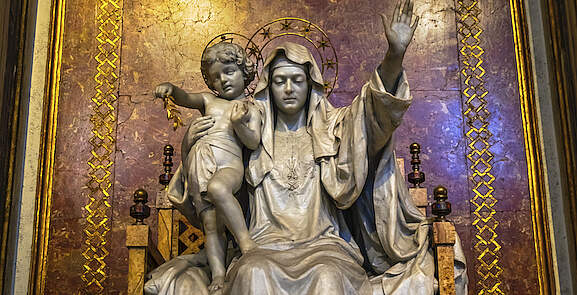
A visit to the Liberian Basilica, as it is often called in honor of Pope Liberius, enriches both the mind and soul. Indeed, it is not uncommon to see visitors rapt in admiration before the spellbinding beauty of the artwork nor, at the same time, to observe the devotion of all those engrossed in prayer in search of comfort and assistance before the image of Mary, who is venerated here under the beloved title of Salus Populi Romani.
Every August 5th, a solemn celebration recalls the Miracle of the Snows. Before the amazed eyes of the congregation, a cascade of white petals descends from the coffered ceiling, blanketing the crypt. From the very beginning of his pontificate, Saint John Paul II requested that an oil lamp burn day and night under the icon of the Salus Populi Romani, as witness to his great devotion to the Madonna.
Santa Maria Maggiore Basilica stands on the site of a temple to the goddess Cybele. According to a 13th-century legend, the first church was built here by Pope Liberius (352-66), on the site of an apparition of the Blessed Virgin Mary. The legend has it that the Virgin appeared to Pope Liberius and the patrician Giovanni Patrizio on August 4, 352 (or 358), instructing them to build a church on the Esquiline Hill. That night, the floor plan was outlined by a miraculous snowfall.
This was a time when churches dedicated to Mary were beginning to spring up all over the empire, prompted by an increasingly popular devotion to the Blessed Virgin and the official acceptance of her title "Theotokos" (Mother of God) at the Council of Ephesus in 431.